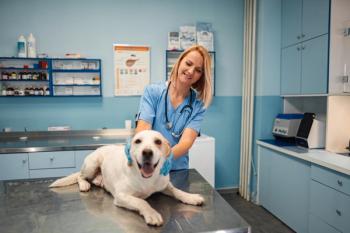
3 nutrition tips for diabetic pets
Make sure your veterinary clients offer the nutritional support their diabetic pets need-and lock in compliance with the veterinarian's recommendations.
Diabetes can be tricky to manage at first, but following the prescribed treatment plan makes it much more manageable for pet owners, says Julie Mullins, a Firstline Editorial Advisory Board member and the team training coordinator at Seaside Animal Care in Calabash, N.C.
It's critical, she says, for pet owners to feed the diabetic pet the diet the doctor recommends in the prescribed amount. It's also important to make sure pet owners feed two meals a day rather than free feeding and follow the testing and monitoring protocol prescribed by the doctor. Help lock in compliance by teaching pet owners to follow these three simple steps:
1. Feed meals and monitor the pet's intake
"An important factor when managing diabetes is to have an ideal balance of insulin and nutrition," says Ciera Miller, CVT, a Firstline board member and technician at Metzger Animal Hospital in State College, Pa. "We need to stress the importance of monitoring the patient's food intake so the pet receives the proper amount of insulin." She adds that if a pet's eating habits vary, the veterinarian may need to adjust the pet's insulin dose. So it's important to instruct pet owners to contact you when they notice changes in their pet's appetite.
2. Feed the high-quality diet the doctor recommends
Keep in mind, some finicky furred friends simply turn their noses up at what's offered. So pet owners need to keep the veterinary team updated on what their pets are—and aren't—eating. Mullins says she asks follow-up questions, like, "What are Fluffy's favorite treats?" and "Does Rover beg at the table?" "This way I'm able to see if they're sabotaging the prescribed diet and treatment through careless snacking," she says.
3. Monitor the types and amounts of snacks in between meals.
Food logs are beneficial, Mullins says, and they offer the benefit of showing pet owners what they're really feeding.
"If pet owners would still like to give their pets snacks, recommend healthy treats in moderation to prevent improper levels of insulin in the body," Miller says.
Finally, act as a liaison for the practice. Mullins says her practice designates a technician to work with diabetic pets, and Miller's practice has a technician who serves as a client care coordinator to call clients for updates. "Sometimes simply knowing there's someone available makes pet owners feel less alone," Mullins says.
Portia Stewart is a freelance writer in Lenexa, Kan. Share your comments at
Newsletter
From exam room tips to practice management insights, get trusted veterinary news delivered straight to your inbox—subscribe to dvm360.






